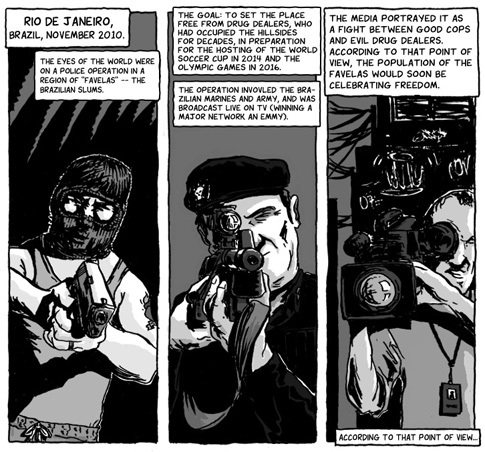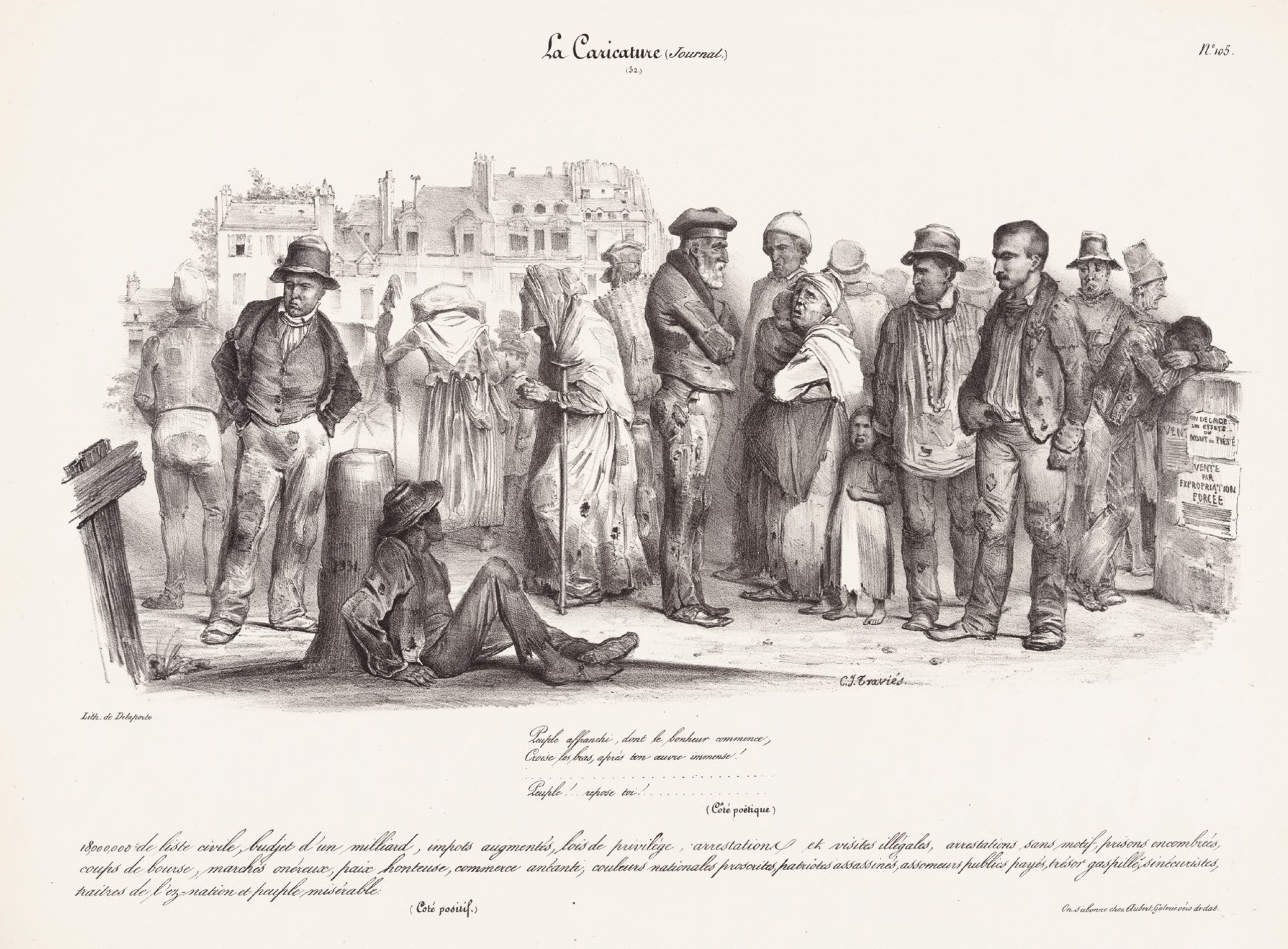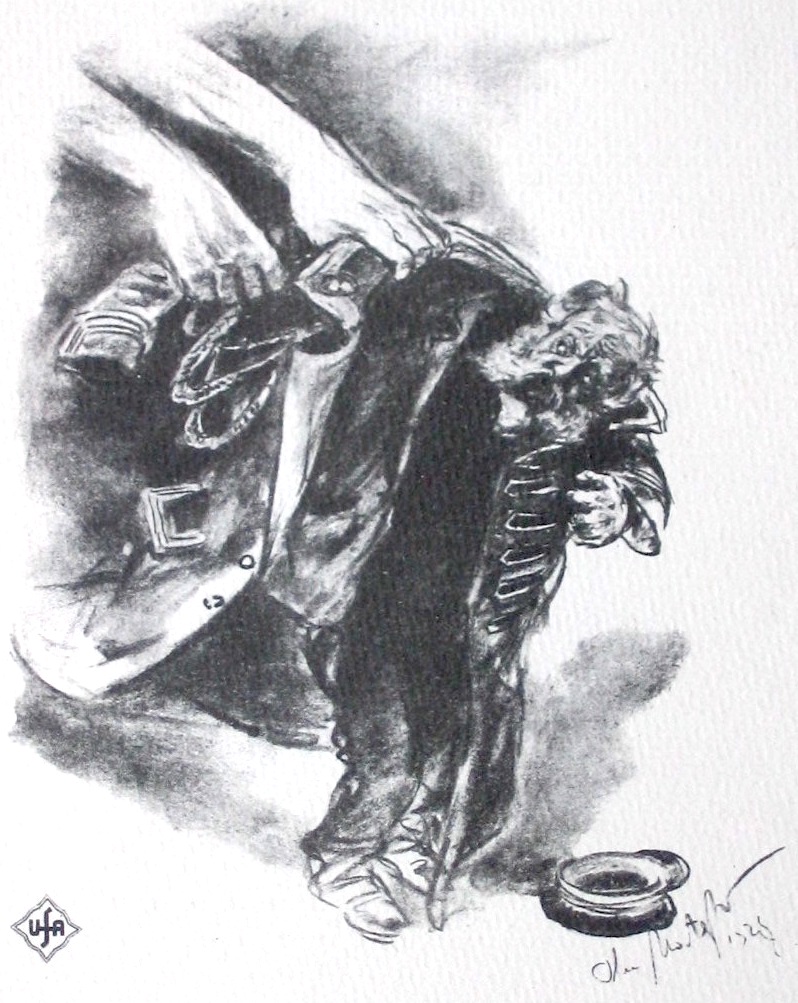Augusto Paim]
[June 30, 2012
Approaches between Palestine and Rio de Janeiro. Some reflections on comic journalism.
Since I read Joe Sacco’s Palestine Special Edition, and its preface entitled ‘Some reflections on Palestine’, in which the author explains the process of producing the masterpiece of his youth, I started to wonder about the relation between Sacco’s comics and my own work. But there is another circumstance. When Sacco came to Brazil in July 2011, people were constantly annoying him with questions about the possibility of producing a comic report in our country. The journalists wanted him to write and draw about Brazil’s main social problems: the illegal drug traffic in Rio de Janeiro or the landless workers around the country and so on. He answered several times with another question: ‘Why me? Isn’t there any Brazilian journalist who could do it?’
It was early July when he came. By that time, I was arranging a trip to Rio de Janeiro, which was going to happen by the end of that same month. My goal was to write a comic report for the international publishing platform Cartoon Movement about the slums of Rio de Janeiro and their problems with drug dealers. However, this story began long before Sacco’s presence in Brazil. In June 2010, I wrote a script intitled ‘Juventude em tempo de crescer’ [‘Juventude in time to grow up’], illustrated by the Brazilian artist Ana Koehler, about a Brazilian soccer team which had had a glorious past, but nowadays faces a really bad phase (and it even got worse a couple of months after the publication of the work) . By that time, I was committed with the organization of the First International Comics Journalism Meeting, altogether with Goethe-Institut of Porto Alegre. The event took place in October 2010, and included a small exposition of comic reports artists from different countries around the world. During the arrangements for the exhibition, I got in touch with the American comic journalist Dan Archer, with whom I had the possibility to exchange experience. Later on, I discovered that he had linked my work with Ana Koehler in his website.
Augusto Paim & MauMau: Inside the Favelas
From Archer’s website, Matt Bors, editor of Cartoon Movement, discovered my work. In December 2010, he e-mailed me and proposed a comic report. We discussed the details for weeks. I had to approach an international subject. I offered him the idea of developing a piece of work about the slums in Rio de Janeiro, because I have been writing about the issue since 2007, which resulted two articles for a magazine. Another reason is because in November 2010 the military occupation of Alemão’s slum was broadcasted worldwide by all Brazilian TV channels. Challenge accepted. I invited the illustrator Maumau to go to Rio de Janeiro with me and to be the responsible for the drawings. Then we worked. The result of our journey was a series of two comics intitled “Inside the favelas” and “Inside the Maré”, published in October and November 2011. The experience was so intense it makes me reflect about some deep issues even a long time after I had finished the script. I confess that the result did not show some of the important parts of the process involved in a comic report. Anyway, they might not have interested our readers. But for me, who keep thinking about the language of comic journalism, and who is constantly struggling to stimulate some discussion here in Brazil, this comic report represents only the top of the iceberg of my personal journey.
Joe Sacco’s preface brought up some hidden ideas inside my mind. To be clear: it helped me having insights at that moment which otherwise would have taken a few years to come up (as it might have happened with Sacco at some moment in his life). Also, I believe his experience in Palestine was quite similar to mine in Rio. Of course, both cases represent the coverage of conflicts, but there are other similarities involved like: our expectations, our fears and the moments of our lives, furthermore, there was the physical structure available for working… I identified myself especially with Sacco’s method of research. He wrote: “When I got to Jerusalem, I was armed which a few addresses of non-governmental organizations and information centers that worked on Palestinian concerns.” He actually means “only with those addresses”. I had also used this method when we went to Rio de Janeiro. We arrived there on a Friday armed with a notebook containing telephone numbers of several people and institutions within different slums. We already had an appointment with some people scheduled for Saturday, but my idea was to decide who to interview and where to go according to the natural development of the work. I kept my mind open to all the new situations we would face. And it worked very well.
I specially appreciate Joe Sacco’s honesty. In Palestine’s preface, he relates his fears, his sense of guilt and his self-questionings. He tells us that a person in a law office once asked him ‘How could a journalist help saving the Palestinian people?’ He did not know the answer. Neither do I. For me, writing about the slums represent a constant self-questioning about being sort of an invader and the feeling of using the circumstances of extreme poverty for my own profit. In order to escape from this thoughts, I try to avoid the common journalist mistakes when faced with this dilemmas: feeling pity on the dwellers; seeing the drug dealers just as villains; showing only violence, not the other side of the life in the slums – the culture, the social projects, and so on; or even celebrating the ‘favela culture’ as a way to feel less guilty. It must be clear that journalists come in and out the slums, but the dwellers stay where they are. It is imperative to respect their place and treat the people there as human beings, not as victims.
Augusto Paim & MauMau: Inside the Maré
Another Sacco’s subject is the interview itself. He wrote: ‘I seldom had the luxury of a one-on-one interview. Doors that were open to me were open to everyone else, too.’ He had also registered in his personal journal about the difficulties on approaching some difficult topics: ‘often I don’t have my questions answered’. That is an amazing and honest testimony. In order to interview the dwellers about issues in the drugs traffic, I had to go slowly, gain confidence of the interviewed people, step-by-step. And, while they were talking, I knew their discourses were not ‘exclusive’. The dwellers are used to talk to journalists. They know what and how much information they can provide, and what they cannot. They know which topics the journalists are interested in about the slums. And many professionals are not careful with the sources of interviews. Since a journalist gets a pretty genuine and sincere testimony (Sacco gives the example of a young boy in Gaza Strip as the perfect source, and mine was a man whom I interviewed in Favela do Sapo), he or she must be careful, because the things he or she publishes may turn into a big problem for the interviewed. And I am talking about death risks.
Finally, Sacco devotes a big part of Some reflections on Palestine to speculate the graphic language involved in comics and its use for journalistic goals. He makes some precious reflections on the importance of editing, using photography and writing the script. This is a treasure, a very important legacy for young comic journalists interested not only in experiencing a new language, but also in creating something socially and ethically rewarding. We, who work with and study comic journalism, need to reflect with Joe Sacco.






